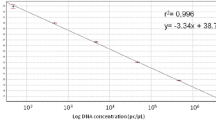Abstract
Specific, sensitive, and rapid detection of quarantine and regulated plant pathogens is pivotal for the control of the diseases they cause. Here, we describe the PCR-based methods which have been developed for Curtobacterium flaccumfaciens pv. flaccumfaciens (Cff), quarantine plant pathogenic bacterium for EU and causal agent of bacterial wilt of Leguminous plants. These methods include an end-point and a real-time PCR test, and a LAMP assay. Their threshold analytical limits range from 100 to 10 fg of DNA template per reaction and are currently used worldwide for routine testing for Cff from laboratory to field scale.
Access this chapter
Tax calculation will be finalised at checkout
Purchases are for personal use only
Similar content being viewed by others
References
Jeger M, Bragard C, Caffier D et al (2018) Pest categorisation of Curtobacterium flaccumfaciens pv. flaccumfaciens. EFSA J 16:e05299
Osdaghi E, Young AJ, Harveson RM (2020) Bacterial wilt of dry beans caused by Curtobacterium flaccumfaciens pv. flaccumfaciens: a new threat from an old enemy. Mol Plant Pathol 21:605–621
Hedges F (1922) A bacterial wilt of beans caused by Bacterium flaccumfaciens nov. sp. Science 55:433–434
Tegli S, Cerboneschi M, Vidaver AK (2017) Detection of Curtobacterium flaccumfaciens pv. flaccumfaciens in bean seeds and in seeds of other Leguminosae crops. In: Fatmi M, Walcott RR, Schaad NW (eds) Detection of plant-pathogenic bacteria in seed and other planting material, 2nd edn. APS Press, St Paul, pp 77–83
EPPO (2011) Curtobacterium flaccumfaciens pv. flaccumfaciens. Bull. EPPO OEPP 41:320–328
The European Commission (2019) European Commission Implementing Regulation (EU) 2019/2072. Off J Eur Union. https://eur-lex.europa.eu/eli/reg_impl/2019/2072/oj
González AJ, Tello JC, Rodicio MR (2005) Bacterial wilt of beans (Phaseolus vulgaris) caused by Curtobacterium flaccumfaciens in Southeastern Spain. Plant Dis 89:1361
Sammer UF, Reither K (2012) Curtobacterium flaccumfaciens pv. flaccumfaciens on soybean in Germany – a threat for farming. J Phytopathol 160:314–316
Harveson RM, Schwartz HF, Urrea CA et al (2015) Bacterial wilt of dry-edible beans in the central high plains of the US: past, present, and future. Plant Dis 99:1665–1677
Gonçalves RM, Schipanski CA, Koguishi L et al (2017) Alternative hosts of Curtobacterium flaccumfaciens pv. flaccumfaciens, causal agent of bean bacterial wilt. Eur J Plant Pathol 148:357–365
Osdaghi E, Taghavi SM, Hamzehzarghani H et al (2018) Epiphytic Curtobacterium flaccumfaciens strains isolated from symptomless solanaceous vegetables are pathogenic on leguminous but not on solanaceous plants. Plant Pathol 67:388–398
Camara RC, Vigo SC, Maringoni AC (2009) Plant to seed transmission of Curtobacterium flaccumfaciens pv. flaccumfaciens in a dry bean cultivar. J Plant Pathol 91:549–554
Tegli S, Sereni A, Surico G (2002) PCR-based assay for the detection of Curtobacterium flaccumfaciens pv. flaccumfaciens in bean seeds. Lett Appl Microbiol 35:331–337
Tegli S, Biancalani C, Ignatov AN et al (2020) A powerful LAMP weapon against the threat of the quarantine plant pathogen Curtobacterium flaccumfaciens pv. flaccumfaciens. Microorganisms 8:1705
Bertani G (1951) Studies on lysogenesis. I. The mode of phage liberation by lysogenic Escherichia coli. J Bacteriol 62:293–300
Acknowledgments
This work was supported by Ministero della Difesa, SFINGE project, coordinated by S.T.
Author information
Authors and Affiliations
Corresponding author
Editor information
Editors and Affiliations
Rights and permissions
Copyright information
© 2022 The Author(s), under exclusive license to Springer Science+Business Media, LLC, part of Springer Nature
About this protocol
Cite this protocol
Tegli, S., Gaudioso, D., Stefanucci, D. (2022). Innovative Detection of the Quarantine Plant Pathogen Curtobacterium flaccumfaciens pv. flaccumfaciens, Causal Agent of Bacterial Wilt of Leguminous Plants. In: Luchi, N. (eds) Plant Pathology. Methods in Molecular Biology, vol 2536. Humana, New York, NY. https://doi.org/10.1007/978-1-0716-2517-0_15
Download citation
DOI: https://doi.org/10.1007/978-1-0716-2517-0_15
Published:
Publisher Name: Humana, New York, NY
Print ISBN: 978-1-0716-2516-3
Online ISBN: 978-1-0716-2517-0
eBook Packages: Springer Protocols




